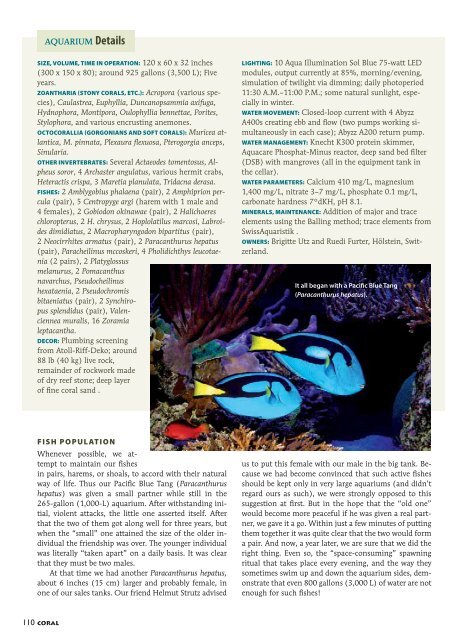You also want an ePaper? Increase the reach of your titles
YUMPU automatically turns print PDFs into web optimized ePapers that Google loves.
AQUARIUM Details<br />
SIZE, VOLUME, TIME IN OPERATION: 120 x 60 x 32 inches<br />
(300 x 150 x 80); around 925 gallons (3,500 L); Five<br />
years.<br />
ZOANTHARIA (STONY CORALS, ETC.): Acropora (various species),<br />
Caulastrea, Euphyllia, Duncanopsammia axifuga,<br />
Hydnophora, Montipora, Oulophyllia bennettae, Porites,<br />
Stylophora, and various encrusting anemones.<br />
OCTOCORALLIA (GORGONIANS AND SOFT CORALS): Muricea atlantica,<br />
M. pinnata, Plexaura flexuosa, Pterogorgia anceps,<br />
Sinularia.<br />
OTHER INVERTEBRATES: Several Actaeodes tomentosus, Alpheus<br />
soror, 4 Archaster angulatus, various hermit crabs,<br />
Heteractis crispa, 3 Maretia planulata, Tridacna derasa.<br />
FISHES: 2 Amblygobius phalaena (pair), 2 Amphiprion percula<br />
(pair), 5 Centropyge argi (harem with 1 male and<br />
4 females), 2 Gobiodon okinawae (pair), 2 Halichoeres<br />
chloropterus, 2 H. chrysus, 2 Hoplolatilus marcosi, Labroides<br />
dimidiatus, 2 Macropharyngodon bipartitus (pair),<br />
2 Neocirrhites armatus (pair), 2 Paracanthurus hepatus<br />
(pair), Paracheilinus mccoskeri, 4 Pholidichthys leucotaenia<br />
(2 pairs), 2 Platyglossus<br />
melanurus, 2 Pomacanthus<br />
navarchus, Pseudocheilinus<br />
hexataenia, 2 Pseudochromis<br />
bitaeniatus (pair), 2 Synchiropus<br />
splendidus (pair), Valenciennea<br />
muralis, 16 Zoramia<br />
leptacantha.<br />
DECOR: Plumbing screening<br />
from Atoll-Riff-Deko; around<br />
88 lb (40 kg) live rock,<br />
remainder of rockwork made<br />
of dry reef stone; deep layer<br />
of fine coral sand .<br />
LIGHTING: 10 Aqua Illumination Sol Blue 75-watt LED<br />
<br />
simulation of twilight via dimming; daily photoperiod<br />
11:30 A.M.–11:00 P.M.; some natural sunlight, especially<br />
in winter.<br />
WATER MOVEMENT: Closed-loop current with 4 Abyzz<br />
A400s creating ebb and flow (two pumps working simultaneously<br />
in each case); Abyzz A200 return pump.<br />
WATER MANAGEMENT: Knecht K300 protein skimmer,<br />
Aquacare Phosphat-Minus reactor, deep sand bed filter<br />
(DSB) with mangroves (all in the equipment tank in<br />
the cellar).<br />
WATER PARAMETERS:<br />
<br />
carbonate hardness 7°dKH, pH 8.1.<br />
MINERALS, MAINTENANCE: Addition of major and trace<br />
elements using the Balling method; trace elements from<br />
SwissAquaristik .<br />
OWNERS: Brigitte Utz and Ruedi Furter, Hölstein, Switzerland.<br />
It all began with a Pacific Blue Tang<br />
(Paracanthurus hepatus).<br />
FISH POPULATION<br />
Whenever possible, we attempt<br />
to maintain our fishes<br />
in pairs, harems, or shoals, to accord with their natural<br />
way of life. Thus our Pacific Blue Tang (Paracanthurus<br />
hepatus) was given a small partner while still in the<br />
265-gallon (1,000-L) aquarium. After withstanding initial,<br />
violent attacks, the little one asserted itself. After<br />
that the two of them got along well for three years, but<br />
when the “small” one attained the size of the older individual<br />
the friendship was over. The younger individual<br />
was literally “taken apart” on a daily basis. It was clear<br />
that they must be two males.<br />
At that time we had another Paracanthurus hepatus,<br />
about 6 inches (15 cm) larger and probably female, in<br />
one of our sales tanks. Our friend Helmut Strutz advised<br />
us to put this female with our male in the big tank. Because<br />
we had become convinced that such active fishes<br />
should be kept only in very large aquariums (and didn’t<br />
regard ours as such), we were strongly opposed to this<br />
suggestion at first. But in the hope that the “old one”<br />
would become more peaceful if he was given a real partner,<br />
we gave it a go. Within just a few minutes of putting<br />
them together it was quite clear that the two would form<br />
a pair. And now, a year later, we are sure that we did the<br />
right thing. Even so, the “space-consuming” spawning<br />
ritual that takes place every evening, and the way they<br />
sometimes swim up and down the aquarium sides, demonstrate<br />
that even 800 gallons (3,000 L) of water are not<br />
enough for such fishes!<br />
110 CORAL

















